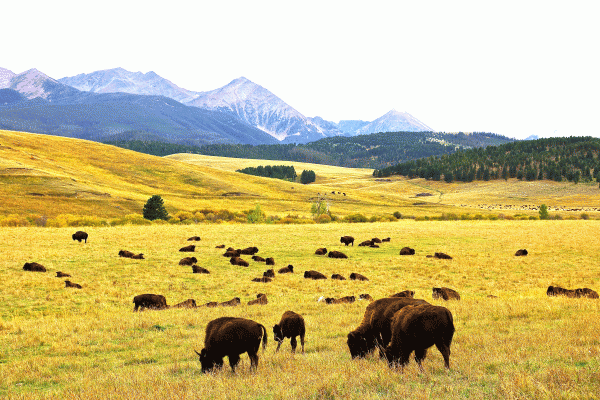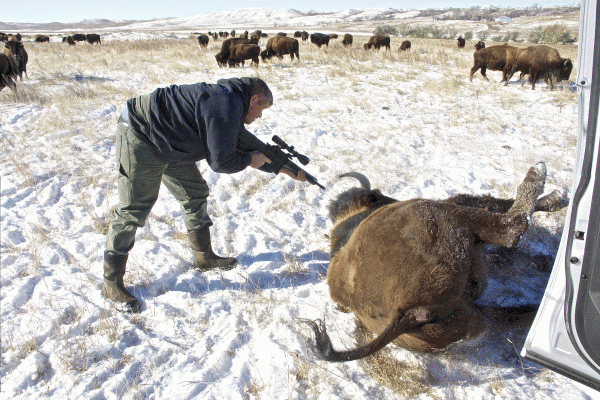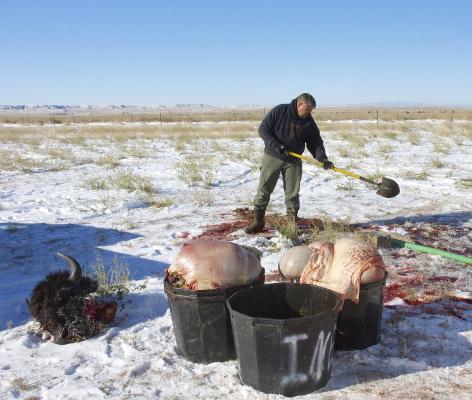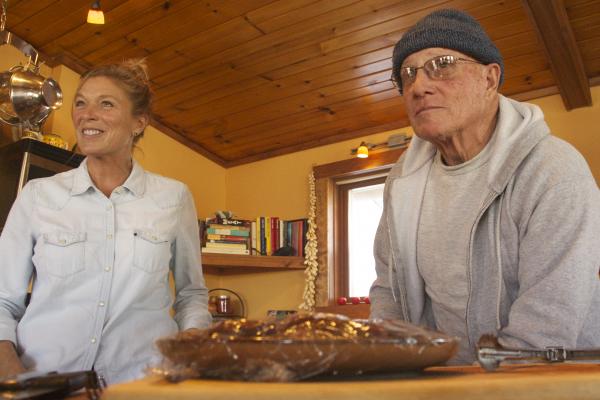Saving the American Buffalo by Killing It
By Josephine Marcotty and Dave Hage
Jerry Blanks took careful aim through the powerful scope on his black hunting rifle as the buffalo surrounding the pick-up truck watched him quizzically. His eye was focused on the dark fur just behind the ear of a young bull that stood just slightly apart from the group.
The sudden crack of the rifle fractured the winter silence and the bull toppled slowly into the snow— just another of the millions upon millions of buffalo that have been killed on these northern plains in the last two centuries.
But this time it’s different. That buffalo is part of an audacious mission by South Dakota rancher Dan O’Brien to save one of America’s most revered wild animals by eating it. He’s one of a small, but growing number of bison producers—including billionaire turned philanthropist Ted Turner— who want to preserve the great landscapes of the west by changing how America gets its protein.
“It’s the only way to bring buffalo back in a meaningful way,” said O’Brien, who 18 years ago turned his cattle operation over to a herd of buffalo that live and die on their native grasslands just as nature intended. “Without money flowing in and out it will fail.”
For 300,000 thousand years, bison were the keystone species of the western United States. They grazed across the lands that stretched from southern Canada to northern Mexico, thundering across the plains in numbers that stunned the Europeans who first encountered them.
But by a hundred years ago they were almost extinct, their vast numbers decimated by a mere two centuries of hunting and, at the end, a calculated plan of extermination by the federal government.
“They were a major force of nature,” said Keith Aune, a biologist with the Wildlife Conservation Society, a leader in the fight to bring them back. “An animal that shaped the landscape and provided a livelihood for entire societies became almost non-existent.”
As European settlers flowed across the west in with a mission to conquer the wilderness, bison were replaced with domesticated cattle that were ill suited to the arid, frigid plains.
Now, a ten-year campaign by conservationists, Indian tribes and the federal government to bring this “forgotten” wild animal back to its native lands is gaining traction. In November, the descendants of some of Yellowstone’s wild bison were trucked to northern Montana, where they were joyfully greeted by the Assiniboine and Sioux Indian tribes at Fort Peck. The Department of the Interior this year issued its long range plan to find federal lands suitable for wild herds, and the American Prairie Reserve, a privately held prairie restoration project in Montana, is slowly increasing in size and adding buffalo as it goes.
But the buffalo were never really gone. They were just turned into livestock and treated like cattle. For decades they have been confined by fences, bred for temperament, and, like cattle, forced to fatten up on corn in feedlots and ultimately sent to slaughterhouses.
Today, there are an estimated 500,000 buffalo in the United States and 90 percent of them are in livestock herds that carry the genes of cattle through failed attempts in the 1950s to breed the two species together.
Those livestock herds present a problem and an opportunity for conservationists. Confined by fences and finished in feedlots, they are simply an extension of the agricultural and livestock industries that have decimated the vast majority of the American prairies. But if raised, as they evolved, on open lands to graze purely on native grasses, they could be the key to restoring much of what’s been lost.
“If bison kept by private ranchers are not included in the ranks of herds that may contribute to ecological recovery, 96 percent of the world’s North American bison will be lost with one stroke,” concluded the authors of the 2005 Vermejo statement, the founding mission statement of the modern bison recovery movement.
Perhaps more importantly, “an opponent, the bison industry, will have been created instantly where an ally may have stood,” they concluded.
Besides, without predators—the wolves, bears, mountain lions and Indians that once kept their numbers in check—something will have to eat them. And that means us.
Today the bison meat business is worth about $300 million, a tiny fraction of the beef industry, but demand and prices are rising fast. The question that has buffalo producers and those in the conservation movement eyeing each other warily is how the animals will be raised—as managed livestock, wild animals or something in between?
“The human footprint has to be a factor,” said Aune. The question is “what level of human footprint do you accept?”
On a crystal cold day in early November a semi-trailer truck rumbled down a dirt road cut through rolling hills of western South Dakota. The grass that stretched from horizon to horizon turned gold as the sun rose above a distant ridge. A black pick-up followed the truck’s dust plume as it pulled through a gate into a pasture, where it stopped.
It was Thursday. Harvest day.
It’s taken Dan and Jill O’Brien, a faithful cadre of investors and their slowly growing group of employees 18 years to figure out how to construct the Wild Idea Buffalo Company, a purely grass-fed bison meat business, that lives up to their moral and ecological standards. Much of it is recounted in O’Brien’s poetic memoir of life on the grasslands, “Buffalo for the Broken Heart.”
It all starts with the truck, an “in-field slaughter operation.” Tucked inside are the knives, saws and hoists necessary to take apart a 1,000-pound animal in about 45 minutes. In the back is a refrigerated compartment that can hold a dozen stripped carcasses.
“We are taking the plant to the animal,” said Jeff Merchant, Wild Idea’s plant manager.
As the sun rose above the ridge, Blanks climbs into the pickup truck with a rifle in hand, and goes off to find O’Brien’s herd of 350 buffalo. After the sudden cold snap froze the ponds, he figured the buffalo headed down to the Cheyenne River that meanders through O’Brien’s land.
Sure enough, that’s where he found them.
When he first took on the job eight years ago, Blanks was following what he calls “a primeval drive to hunt.” That’s all changed.
“Now I can see why the Indians held them in such reverence,” he said. Over the years he’s developed a respectful patience as he drives the pick-up slowly through the herd, looking for an animal that is the right age, the right size, and in just the right spot. After careful research he’s found the right bullet, one that penetrates the skull, but won’t blow through the other side—a 30 caliber, all copper. This, he said, is the best way they can die, living in their herd on their native land right up until their last breathe.
“If I didn’t do this, they would be going another route,” he said.
When the gun cracks and the bull drops to the ground, the other animals don’t seem to notice. That’s because there is no bellowing, no thrashing, to spook them, Blanks said. By following humane kill guidelines, the bull is rendered insensible by the bullet, and dies when Blanks cuts its throat, leaving a red stain on the snow.
When the smell of warm blood drifts toward the bison watching the scene, their nostrils flare as they raise their noses in the air to catch the scent.
Blanks backs the truck up to the carcass, wraps chains around the front and back hooves, and, with a specially designed hydraulic lift, hoists the animal feet first into the air.
Slowly, he drives back up the hill with the dead buffalo swaying in the air behind the truck, to where the slaughter truck waits.
By 4 p.m., the crew has killed and slaughtered eight buffalo, their stripped and headless carcasses hanging in the refrigerated section of the truck. As it pulled out of the pasture to deliver them to the Wild Idea processing plant in Rapid City, it left behind a wide stain of blood in the snow and big buckets of intestines and beach ball like stomachs full of grass destined for an offal pit elsewhere on the ranch.
And that’s where it belongs, O’Brien said, left behind to replenish the ecosystem as food the scavengers and enrichment for the soil.
“Taking the dead animal impoverishes the land,” he said.
Today Wild Idea is a thriving little business, with sales that have increased 30 percent in each of the last two years. But it’s tiny— O’Brien compares it to a pricey boutique winery. Unlike most of the beef and bison industries, it’s vertically integrated. It starts with the living animal and ends with a cut of meat or finished ready-to-eat product packed in dry ice and shipped out via UPS. Wild Idea sells direct through its web site, wildidea.com, to customers, restaurants and grocery stores willing to pay a premium price.
That structure is the only way the O’Brien’s could bypass the feedlots and slaughterhouses that are cruel, and environmentally destructive, he said.
“I wouldn’t do that to my dog,” he said.
More importantly, it’s not necessary, he said. Bison evolved to eat only grass—about 30 pounds a day— and pure grass fed bison meat is much lower than beef in fat, calories and cholesterol. A long November afternoon of tasting different cuts and ways of cooking bison in Jill O’Brien’s kitchen proved that the flavor is clean, sweet and utterly delicious.
Part of that, O’Brien said, is that they are devoid of the stress hormones that alter the flavor of animals that are forced onto trucks, into feedlots and down the chutes to the killing room.
O’Brien’s “messianic” goal, as he puts it, goes far beyond delivering boutique meat to an elite audience. Saving the bison also saves the prairie and a rich ecosystem that’s on a par with the African Serengeti. The bison’s grazing spreads the seeds and replenishes the grasses. Healthy grasses provide a home for hundreds of birds, pollinators, and deer—plus the coyotes and even wolves that rely on them in nature’s endless food chain.
“Our product is species diversity,” O’Brien said.
So far, he says, his buffalo are having an impact on 350,000 acres. That includes the 4,000 acres he owns, his partner’s neighboring 5.000 acre ranch, an adjacent 70,000 acres of the Buffalo Gap National Grasslands where they have grazing rights, plus land owned by The Nature Conservancy and nearby tribes that sell their bison to him for slaughter.
But there is a long way to go. Today, there is not much left of the vast prairies that once stretched from the Mississippi to the Rockies. Every year more grasslands are converted into corn, soybeans and other crops—close to 40,000 square miles in the last half-decade alone.
Two-thirds of the corn in the United States is grown to feed livestock—poultry, pork, beef and buffalo—in feedlots. That, combined with a market driven by ever-higher federal mandates for ethanol, has made America’s native prairies one of the most threatened ecosystems on Earth.
“You will never get it back,” O’Brien said.
The climate pays a price as well. The vast underground root systems for native grasses reach depth of eight or nine feet and hold an astonishing one-third of the world’s carbon stocks. On average, every time an acre of native grassland is plowed, it releases 60 tons of carbon dioxide into the atmosphere -- about the amount emitted annually by 30 passenger cars.
In short, said O’Brien, feedlots “are driving a commodity model that is catastrophic. If there’s a sin, that’s it.”
But Wild Idea’s bison are a rarity. The American Bison Association has 1,000 members, and about half raise grass fed animals, said Dave Carter, executive director. Like O’Brien, however, they are the small operators. About 80 to 90 percent of the 113,000 bison that are slaughtered each—a fraction compared to the 32 million head cattle industry—end their lives in feedlots.
That’s because customers demand it, bison producers say. Even philanthropist Ted Turner, who became the largest bison producer in the country in order to protect the species and preserve the land, finishes them in feedlots before trucking them to Colorado for slaughter.
Turner gets high marks from bison conservationists because he manages them with a light touch and with their long-term interests in mind.
At the Flying D near Bozeman, the largest of Turner’s operations, the herd spends most of its life in buffalo heaven—115,000 acres of sprawling meadows below the Spanish Peaks. They share this sweeping green land with elk, moose, grizzlies and even two packs of wolves that have recently taken up residence.
The ranch hands say they have marveled at how the ancient genes that have kicked in as the bison learned how to defend their calves against the predators.
“(Turner) said long ago that he never saw a species that had commercial promise that was endangered, ” said Mark Kossler, who manages Turner’s bison operations, which includes about 50,000 animals on 14 of his 15 ranches from South Dakota to New Mexico. “So we are ranching bison as part of the conservation effort.”
But decades of industrial cattle operations has had enormous influence on the structure of the bison business and consumer tastes that influence Turner Enterprises and other producers who are struggling to survive in a volatile industry.
Bison can taste different depending on where it’s been raised, what it’s been eating and what time of year it’s been slaughtered. That doesn’t always go over well with restaurants or consumers who expect all meat to be the same.
“It’s part of the game to have a consistent product,” said Danny Johnson, manager at the Flying D.
That’s where feedlots come in. Though cattle are much more suited to feedlots, the added food—hay, oats and corn—puts weight on bison and gives them a layer of fat that they don’t naturally have.
“White fat,” said Johnson. “That’s what the public is used to.”
Still, federal rules require that bison meat be free of the growth hormones and antibiotics that are routinely injected into commercial beef cattle to help them tolerate corn and close confinement. And they spend less time in feedlots because their growth maxes out more quickly than cattle.
Carter, of the bison association, said the industry is still figuring out what it’s going to be.
“We learn every step of the way that these are unique animals, and sometimes the best management is the least management,” he said.
O’Brien is still waiting for the rest of the industry to come around to his way thinking—that the best management for American buffalo and its native prairie is no management at all.
“I’ll know I’m successful when Ted Turner switches over,” he said. “It will kill me, but what a way to go.”
###
Josephine Marcotty and David Hage are exploring the American buffalo with their fellowship grant.




